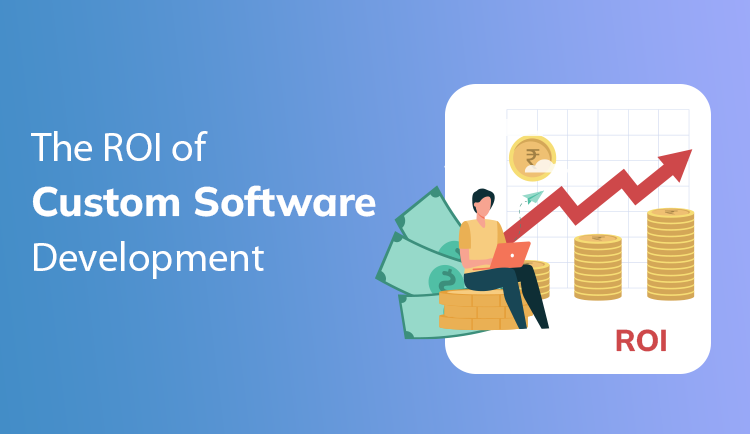
The KPIs of Custom Software Development ROI
Every business makes decisions with the Return on Investment (ROI) in mind in the business world. It is critical to assess ROI, whether it is the ROI for machinery or the custom software development ROI. It assists businesses in understanding how a specific purchase will benefit them in the future.
In recent years, market competition has increased dramatically, requiring businesses to utilize innovation and newer ideas to their advantage. Implementing robust software solutions is imperative to stay ahead of the competition. However, implementing any solution randomly is no good idea. You need to determine the software ROI to understand how it will benefit your business.
When it comes to automating your business processes, you have to choose between custom software development and off-the-shelf software. The simplest and quickest option is undoubtedly off the shelf but not as effective as a well-designed custom software solution.
Custom software development addresses the client’s specific needs while also saving time and money. Today, most businesses prefer to choose tailor-made, cost-effective, time-saving, and high-quality software solutions for their business requirements.
However, the only quandary they face is whether it is worthwhile to invest in custom development software solutions or not. Will it provide a good return on investment? And so forth.
So, if you’re unsure whether you should invest in custom software development or want to know what the custom software development ROI would be, read this post.
Here, we are going to explain everything about the ROI of custom software, including calculating the custom software development ROI and why you should choose custom software development over prepackaged software solutions.
Find the answer of “why you should opt for custom software development.”
Why do businesses need Custom Software Development Services?
Custom software development, as well as the automation of business processes, is critical for businesses. Custom software development can help you automate your processes. It can also be used in other areas of business such as marketing, sales, customer service, manufacturing, and so on.
However, it is important to note that custom software development will necessitate a significant investment. The level of investment and the custom software ROI is determined by the app or software being developed.
Even after determining the need for custom software and selecting the best custom software development company, determining how the new solution will affect your business processes can be challenging.
Of course, every company that invests in a custom software application hopes to reap significant benefits from the transaction, but determining the degree of those benefits isn’t always simple.
Custom software is the ideal solution if you want to reduce costs while increasing revenue.
Here is how…
Custom Software Development ROI = (Reduced Cost + Increased Revenue)/Project Cost
OR
ROI for custom software = (Gain – Cost of Investment)/Cost of Investment
Let’s now take a look at how to calculate software ROI.
Calculating Return on Investment (ROI)
When it comes to assessing the success of software or an application, ROI plays a major role. Measuring custom software ROI can be difficult but not impossible.
To begin, you must ask yourself, “What do you hope to gain from this project?” Presumably, your response should focus on the two or three most important goals for improving your business processes, such as boosting sales, reducing roadblocks, or delivering a higher-quality end product.
After you’ve decided the goal(s) for your custom software development project, it’s time to select the metrics, which could include:
- Sales Metrics: Lead conversion, renewal, and up sell rates.
- HR Metrics: Employee satisfaction and retention.
- Operation Metrics: Improved efficiency and uptime.
Aside from that, you’ll need to identify the key performance indicators that will allow you to track your progress toward your goals. Choosing Key Performance Indicators is a MUST when automating businesses through custom software development.
Businesses must consider both tangible (quantifiable) and intangible (non-quantifiable) KPIs in order to measure custom software development ROI. Here’s a quick rundown of both:
Return on Investment – Tangible KPIs
Improved Sales
Determine whether the implementation of custom software results in increased sales for the company.
If it does, it is indispensable to implement custom software.
Consider factors that will result in increased sales after the software is introduced. Suppose your new software assists you in closing more deals, acquiring more customers, having direct customer contact, or effectively retaining customers. In that case, you’re likely to have improved sales that you can attribute to custom software development ROI.
Process Advantage
Is there any increase in speed, accuracy, and efficiency as a result of automated processes?
You can compare the time spent and errors made before and after the implementation of custom software. Also, examine the cost of carrying out these processes, as well as the efficiency achieved before and after the implementation of software. You have a positive custom software development ROI if the results are positive.
Greater Efficiency
Has employee efficiency improved since the implementation of custom software?
If the answer is yes, then custom software development can be credited with increased efficiency.
You can reallocate the customized software to more productive tasks, increasing employee efficiency and resulting in fewer hours of unproductive or repetitive tasks and greater efficiency.
Increased Production
Is there an increase in production as a result of automation?
If yes, then indeed, custom software development is a safe bet.
As automation of repetitive tasks helps employees to focus on core tasks, such as business development or developing new strategies to increase customer reach, thereby resulting in improved customer retention and delight.
Reduced Costs
Has the implementation of custom software resulted in reduced costs?
If the answer is yes, then indeed a dedicated resource is a MUST HAVE in the business.
Examine your costs to see what direct, and indirect cost reductions have resulted from the company’s new software. Direct cost savings can result from a reduction in the need for hardware as a result of a shift to the cloud or from the elimination of multiple software licenses in cases where your software was designed to replace several stand-alone programs.
So, these are the tangible KPIs that can help you assess custom software development ROI. Let’s now take a look at intangible KPIs.
Even though you cannot quantify them, intangible ROI plays a crucial role when evaluating the success of your custom software.
Intangible KPIs include:
Return on Investment – Intangible KPIs
After you’ve completed a thorough analysis of ROI from a financial standpoint, it’s time to consider intangible ROI. This basically includes all of the business advantages of custom software that are more difficult to assign a number to.
The following are four of the most important intangible KPIs to consider:
Improved Employees Contentedness
Employees are an organization’s most valuable asset. They will never give their best effort if they are unhappy.
Employees who are subjected to repetitive tasks become bored and, as a result, unproductive. Custom software takes over humdrum, low-level, manual tasks, allowing employees to focus on core activities and become happier.
Enhanced Customer Satisfaction
We all know that today’s customers are wealthy in terms of money but not in terms of time. If you make your customers wait for any reason, they will leave you to never return. This will impact your business drastically.
However, automating your business processes can help you have delighted customers. Building custom software can help you achieve your business goals by improving communication between you and your customers, resolving customer service questions faster, and shipping products more quickly, to name a few benefits.
Improved Brand Image
The perception of the brand in the mind of the customer is referred to as a brand image. It is a compendium of a customer’s beliefs, ideas, and impressions about a company. Today, every company strives to have the best brand image possible.
Implementing custom software can significantly help you improve your brand image and achieve your marketing goals. If your dedicated resources result in a better brand image, you can attribute that to the custom software development ROI.
Minimized Error
Implementing custom software automates and synchronizes your business processes, significantly reducing errors in the process.
You don’t need to monitor your processes as the errors will be notified before they occur so that you can take significant measures.
Putting it all together
So, this is all about the custom software development ROI. Hopefully, this post has been enlightening for you and will help you correctly evaluate your custom software ROI.
Know that return on investment is always an essential factor to consider while you make a purchase decision. Evaluating ROI for custom software may seem taxing at first; however, with a tad bit of effort, you can easily calculate it and understand how beneficial a resource could be in the future.
Both tangible and intangible ROIs play a crucial role when it comes to determining the overall success of the software. Of course, one gives you quantifiable results, while the other helps you and your employees have peace of mind and an improved work-life balance.
So, if you’re thinking of investing in a custom software development project, do consider whether the expected results are worth the money you’re willing to pay.




